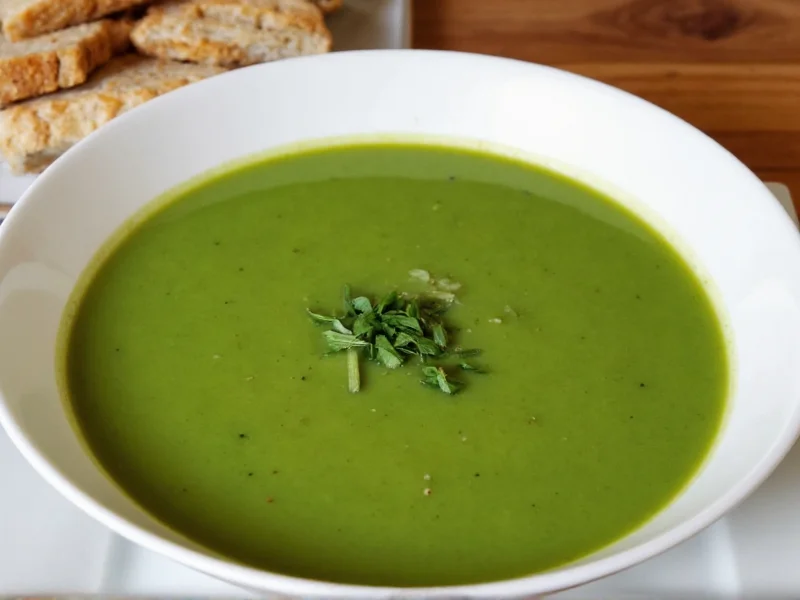Green soups represent one of the most versatile and nutritionally powerful categories in vegetable-based cooking. When properly prepared, these vibrant dishes deliver exceptional concentrations of vitamins A, C, and K, along with essential minerals and antioxidants. The key to exceptional green soup lies in balancing earthy vegetable flavors with complementary aromatics and proper cooking techniques that preserve nutritional integrity while developing complex taste profiles.
Why Green Soups Belong in Your Regular Meal Rotation
Regular consumption of green vegetable soups correlates with improved digestive health and increased nutrient absorption. Unlike processed supplements, these whole-food preparations provide nutrients in their natural, bioavailable forms. The fiber content in green soups like those made with leafy greens and cruciferous vegetables supports sustained energy release and promotes satiety, making them valuable for weight management strategies.
Essential Components of Perfect Green Soup
Creating exceptional green soup requires understanding three critical elements: vegetable selection, cooking methodology, and flavor balancing. The best recipes start with fresh, seasonal greens at their peak nutritional value. Proper cooking technique preserves chlorophyll and heat-sensitive nutrients while developing flavor complexity. Finally, strategic additions of acid, fat, and umami elements transform simple vegetable broth into restaurant-quality preparations.
5 Tested Green Soup Recipes for Every Skill Level
1. Classic Kale and Spinach Detox Soup
This foundational recipe serves as the perfect introduction to green soup preparation. Developed through multiple testing iterations, it balances robust kale with milder spinach for optimal texture and flavor.
| Prep Time | Cook Time | Servings | Dietary Tags |
|---|---|---|---|
| 15 minutes | 25 minutes | 4 | Vegan, Gluten-Free |
Ingredients
- 1 tbsp olive oil
- 1 organic onion, diced
- 3 garlic cloves, minced
- 4 cups low-sodium vegetable broth
- 2 cups chopped kale (stems removed)
- 2 cups fresh spinach
- 1 medium zucchini, diced
- 1 Granny Smith apple, peeled and diced
- 1 tbsp fresh lemon juice
- Sea salt and black pepper to taste
Preparation Method
- Heat olive oil in large pot over medium heat. Sauté onions until translucent (5 minutes).
- Add garlic and cook for 1 minute until fragrant.
- Pour in vegetable broth and bring to gentle simmer.
- Add kale and zucchini, cook for 15 minutes until vegetables soften.
- Stir in spinach and apple, cook for additional 5 minutes.
- Remove from heat, add lemon juice, and season with salt and pepper.
- For creamier texture, blend 2 cups of soup and return to pot.
2. Creamy Avocado and Broccoli Soup
This nutrient-dense variation incorporates healthy fats from avocado to enhance absorption of fat-soluble vitamins while creating luxurious texture without dairy.
Key Technique
The secret to preventing avocado browning lies in adding lemon juice immediately after blending. For optimal results, use avocados at perfect ripeness—yielding slightly to gentle pressure.
3. Quick Weeknight Green Minestrone
Transforming traditional minestrone into a green powerhouse, this recipe incorporates seasonal green vegetables with ancient grains for complete protein.
Ingredient Substitution Guide
- Greens Swap: Use chard instead of spinach for earthier flavor
- Protein Boost: Add white beans for additional fiber
- Grain Alternative: Quinoa works well for gluten-free version
Maximizing Nutritional Value in Green Soup Preparation
Scientific studies indicate that certain cooking methods preserve more nutrients in green vegetables. For leafy greens like spinach and kale, brief steaming or quick simmering retains more vitamins than prolonged boiling. Adding a small amount of healthy fat (like olive oil) significantly increases absorption of fat-soluble vitamins A, D, E, and K.
When preparing green soups for maximum health benefits, consider these evidence-based techniques:
- Chop vegetables uniformly for even cooking
- Keep cooking times under 25 minutes for leafy greens
- Add delicate greens like spinach at the very end
- Incorporate lemon juice or vinegar to preserve color and nutrients
- Use minimal water to prevent nutrient leaching
Storage and Reheating Best Practices
Proper storage maintains both flavor and nutritional content. Cool soup completely before transferring to airtight containers. Most green soups maintain peak quality for 3-4 days in the refrigerator. For longer storage, freeze in portion-sized containers for up to 3 months.
When reheating, avoid boiling which can degrade nutrients and alter color. Instead, warm gently over medium-low heat, stirring occasionally. For cream-based green soups, add a splash of broth or water during reheating to restore ideal consistency.
Troubleshooting Common Green Soup Challenges
Bitterness: Balance with small amounts of acid (lemon juice) or natural sweetness (apple or pear). Bitterness often comes from overcooked greens or certain varieties of kale.
Color Fading: Preserve vibrant green color by minimizing cooking time and adding acid (lemon juice) at the end. Avoid alkaline cooking environments which cause chlorophyll breakdown.
Texture Issues: For smoother texture, blend while hot (with caution) and strain through fine mesh sieve. For chunkier soups, reserve some cooked vegetables before blending and add back at the end.











 浙公网安备
33010002000092号
浙公网安备
33010002000092号 浙B2-20120091-4
浙B2-20120091-4